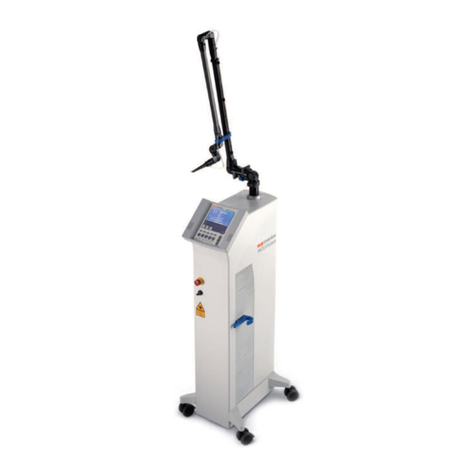
Operating Instructions
Surgical Laser Unit Limax®120
5.3 Front Side ..........................................................................................24
5.4 Rear Panel ......................................................................................... 26
5.4.1 Drawer..........................................................................................................27
5.4.2 Loudspeaker ..................................................................................................27
5.4.3 Laser MCB Interface .......................................................................................28
5.4.4 Service Interface............................................................................................28
5.4.5 Service Connector ..........................................................................................28
5.4.6 Accessory Port ...............................................................................................28
5.4.7 Interlock / Warning Connector .........................................................................29
5.4.8 Foot Switch Connector ....................................................................................30
5.4.9 Mains Connector Socket with Cooling System Fuses............................................30
5.4.10 Line Fuses for the Optical System.....................................................................31
5.4.11 Equipotential Bonding Pin ................................................................................31
5.4.12 NIST Socket AIR ............................................................................................31
5.4.13 MCB Interface of the Smoke Evacuator .............................................................32
5.4.14 Information Label...........................................................................................32
5.4.15 Laser Rating Plate ..........................................................................................33
5.4.16 Smoke Evacuator Rating Plate (VAC) ................................................................33
5.4.17 Mains Connection for Smoke Evacuator (VAC)....................................................34
5.5 Initial Instruction by Authorized Person.................................................. 34
5.6 Measures to Be Taken Prior to Using the Laser System ............................ 35
6Operating the Limax®120 ...........................................................36
6.1 Controls, Indicators and Display Elements.............................................. 36
6.1.1 Keylock Switch...............................................................................................37
6.1.2 Emergency Stop Switch ..................................................................................37
6.1.3 STOP Indicator...............................................................................................38
6.1.4 “LASER ACTIVE” Indicator ...............................................................................38
6.1.5 Fiber Connecting Socket..................................................................................39
6.1.6 Keypad .........................................................................................................39
6.1.7 Rotary Switch with Backlighting .......................................................................40
6.1.8 Display .........................................................................................................42
6.1.9 Laser Status Indicator.....................................................................................43
6.1.10 FILTER LIFE ...................................................................................................44
6.2 Connecting the Laser Fiber ................................................................... 45
6.3 Checking the Laser Fiber with the Pilot Laser .......................................... 46
6.4 Replacing the Laser Fiber ..................................................................... 47
6.5 Connecting the Laser Focusing Handpiece / Applicators............................ 47
6.6 Compressed Air Supply........................................................................ 47
6.7Smoke Evacuator (VAC)....................................................................... 49
6.8 Switching on the Unit .......................................................................... 50
6.9 System Test ....................................................................................... 50
6.10 Foot Switch ........................................................................................ 51
V. 2.0 3




























